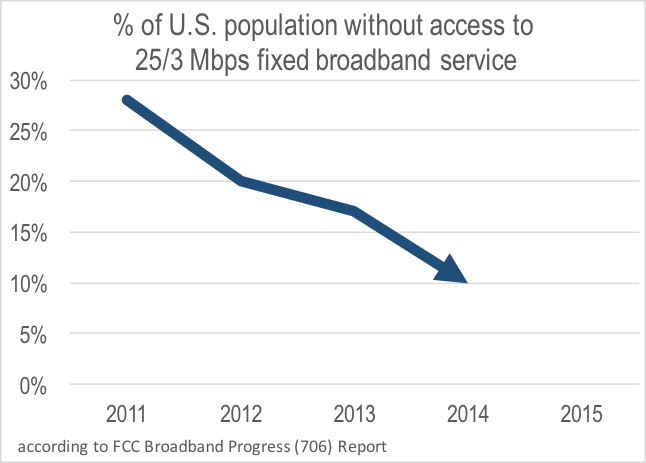In tonight’s State of the Union address, President Obama is likely to highlight the Administration’s success in expanding broadband access for millions of Americans. Yet, according to a document that FCC Chairman Wheeler released last week, in late January the FCC will draw a very different conclusion and find that broadband deployment remains inadequate.
Why does that matter? Because, under a federal law called “Section 706,” the FCC is authorized to “take immediate action” – code words for regulation – if it determines that broadband is not being deployed to all Americans in a “reasonable and timely fashion.
It’s important to understand that the purpose of the Commission’s annual Section 706 Report is to measure progress. If progress is stalled, the Commission is empowered to take action to speed things up. But the chart below, using the FCC’s own data and newly-raised standard for defining broadband, demonstrates that high-speed broadband continues to be deployed rapidly to the American people.
Arbitrarily determining that progress isn’t fast enough in the face of data that proves otherwise can’t be what Congress had in mind with Section 706 .
When examining all the factors that lead to increased broadband deployment, it’s important to understand where the real progress is being made. Since the mid 1990’s, private industry has invested $1.4 trillion in building broadband networks that reach nearly every home. In 2015, telecom and cable providers invested more into American infrastructure than any other industry. And a recent report by the FCC, dropped late in the fading hours of 2015, concluded that all ISPs – but especially cable operators – consistently have been increasing speeds offered to consumers and, in many cases, delivering service that exceeds their advertised speeds. In other words, ISPs are giving customers more than what they were promised.
Instead of promoting America’s broadband progress, the FCC instead decided to redefine how progress should be measured to reach its desired negative conclusion. In 2015, the Commission changed the definition of broadband to produce its favored conclusions, rather than providing an objective assessment of the market. It arbitrarily defined broadband as a 25 Mbps download connection with 3 Mbps upload, which conveniently makes markets look more concentrated and exacerbates the appearance of a deployment problem in rural America. As noted above, the record shows significant progress in offering American consumers broadband access even at this increased rate. But what is worth noting is the extent to which the FCC’s own policy decisions have held back even greater progress.
For instance, if the FCC were serious about closing the gap at 25/3 in rural America, why hasn’t it committed to funding the Remote Areas Fund it created in 2011? Instead, it has not even started to take steps to distribute money through that funding mechanism, even while there is well over $2 billion (and growing) that has been collected through universal service contributions sitting untouched in a reserve fund.
And, why didn’t the Commission offer all the money from the Connect America Fund on a competitive basis to companies that can most efficiently build advanced networks capable of delivering 25/3 service? Instead, the Commission awarded price cap telephone companies $9 billion to provide slower 10 Mbps service to millions of rural Americans. These rural consumers are now relegated, for the better part of the next decade, to receiving DSL service that does not meet the Commission’s own standard for broadband.
The 706 Report was intended by Congress to be an objective and credible analysis that would help guide investment and responsible policy. Unfortunately, it has become an exercise in petty politicking. The report is designed specifically to make things look worse than they are in order to justify government intervention in otherwise well-functioning markets. We can only hope that the bluster surrounding this year’s report gives way to some serious efforts to close the small deployment gaps that still exist, rather than another year of failed policies that waste billions of USF dollars contributed by American consumers.
This blog also appeared in CTAM SmartBrief.

